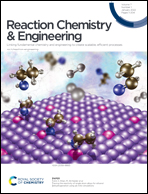Carbonic anhydrase/formate dehydrogenase bienzymatic system for CO2 capture, utilization and storage
Abstract
In order to establish carbon capture, utilization, and storage (CCUS) technology, we focused on a system consisting of two different biocatalysts (formate dehydrogenase from Candida boidinii; CbFDH and carbonic anhydrase from bovine erythrocytes; CA). CA catalyses the interconversion between CO2/water and dissociated bicarbonate ions/protons. CbFDH is a NAD+-dependent dehydrogenase that catalyzes CO2 reduction to formate by using the NAD+/NADH redox couple. The construction of a bienzymatic system consisting of CA and CbFDH (CA/CbFDH system) for a CCUS system was attempted. At 150 or 200 μM CA in the sample solution and a controlled pH of 6.3–6.5 by CO2 bubbling, due to the promotion of the conversion of CO2 to bicarbonate, the reaction rate for CbFDH-catalyzed CO2 reduction to formate decreased to about 50% as compared with that in the absence of CA. In the higher pH region (>9.5), despite the low CO2 concentration in this region, in contrast, it was found that the addition of CA promoted the reduction of CO2 catalyzed by CbFDH to formate to about 7 times higher than that under the conditions without CA. This shows that a CCUS system was constructed in which the conversion of bicarbonate to CO2 using CA and the reduction of CO2 to formate using CbFDH were coordinated.



 Please wait while we load your content...
Please wait while we load your content...